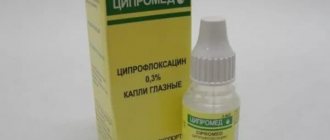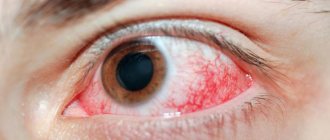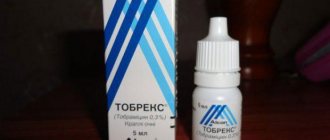Tsipromed - instructions for use
Bacterial infections of the eyes and ears are easy to treat in the early stages. For inflammatory diseases, otolaryngologists (ENT) and ophthalmologists recommend the use of local antibiotics. Tsipromed belongs to the drugs in this group. It is active against many microorganisms that provoke the development of internal and external otitis, blepharitis, dacryocystitis and other inflammatory diseases of the eyelids, eyes and ears. In the postoperative period, the solution is used to prevent secondary infection.
Compound
The medicine is produced in two forms. Eye drops are a colorless or pale yellow liquid. They are packaged in opaque 5 ml bottles; the ciprofloxacin solution includes a pipette. Ear drops are a viscous, colorless or yellowish liquid. The main active ingredient in the drug is ciprofloxacin in the form of lactate. The solution is packaged in opaque dropper bottles of 10 ml. The full composition of the two release forms of Tsipromed is presented in the table below:
| Release form | Components | Concentration in mg |
| Ear drops | Ciprofloxacin lactate | 3 |
| Benzalkonium chloride, lactic acid, propylene glycol | — | |
| Eye drops | Ciprofloxacin hydrochloride | 3 |
| Lactic acid, sodium edetet, sodium hydroxide, sodium chloride, benzalkonium chloride, water for injection | — |
Pharmacodynamics and pharmacokinetics
The antibacterial effect of the drops is due to the presence of ciprofloxacin. This substance belongs to the group of fluoroquinolones and is considered an antibiotic. Ciprofloxacin inhibits bacterial DNA gyrase, which leads to disruption of the synthesis of daughter molecules of deoxyribonucleic acid and cell proteins. The drops are active against the following types of pathogenic microorganisms:
- Escherichia coli and hemophilus influenzae;
- salmonella, pseudomonas, brucella, chlamydia;
- Proteus mirabilis (indole-positive and indole-negative strains);
- Morgana bacterium, Gardnerella vaginalis, Moraxella catarrhalis;
- Citrobacter, Enterobacter, Acinetobacter;
- Klebsiella pneumonia;
- Yersinia, Vibrio, Campylobacter, Hafnia;
- Providence Stewart, Listeria monocytogenes;
- Pasteurella multicida, Legionella pneumophila;
- non-pathogenic Neisseria;
- staphylococci, streptococci;
- diphtheria corynebacterium.
Ear drops are practically not absorbed. The eye solution penetrates into all tissues, breast milk, and through them into the systemic bloodstream. In the anterior chamber of the eye, the maximum concentration of the antibiotic occurs 1 hour after instillation. The half-life of the drug from blood plasma is 5 hours. The drug is excreted from the body by the kidneys (50% - ciprofloxacin, 15% - metabolites of the active substance) and intestines (15%).
Indications for use
Ear drops are used to treat and prevent infectious diseases of the auditory system. They are prescribed for chronic, acute and infectious otitis of any form, before and after surgery, and for ear damage. The solution is used in the dosage specified in the instructions or prescribed by an ENT specialist. Tsipromed for eyes is used in the treatment of the following diseases:
- subacute and acute conjunctivitis;
- keratitis;
- blepharitis and other inflammatory diseases of the eyelids;
- prevention of inflammation after eye injury;
- subacute and acute dacryocystitis;
- anterior uveitis.
Mechanism of action
The drug disrupts protein production in bacterial cells, thereby inhibiting the formation of DNA molecules and elements of the bacterial cell wall. As a result, the death of pathogenic bacterial flora occurs (the so-called bactericidal effect). Ciprofloxacin is a broad-spectrum antibiotic that is active against many gram-positive and gram-negative bacteria. Among them are streptococci, staphylococci, enterobacteria, Klebsiella, salmonella, mycobacteria and others.
The resistance of microorganisms to the active ingredient develops very slowly, which explains the high effectiveness of Tsipromed. In addition, the drug is active against microorganisms that exhibit resistance to antibiotics of other groups - tetracyclines, penicillins, cephalosporins.
The drug acts locally and is practically not absorbed into the bloodstream.
Indications for the use of ear drops may include:
Directions for use and dosage
Drops are used exclusively for the treatment of local inflammation of the eyes or ears. It is prohibited to take them internally. According to the instructions, it is allowed to drip Tsipromed into the nose for a cold. The standard dosage is 2 drops in each nasal opening 2-3 times a day. For ear and eye infections, the dose of the drug depends on the type of disease and the patient's individual response to treatment.
Tsipromed ear drops
According to the instructions, before using the solution, it is necessary to sanitize the external ear canal and then dry it. Tsipromed is instilled into the ears 5 drops 3 times a day. After the symptoms of the disease disappear, therapy is continued for 48 hours. Before using Tsipromed ear drops, you should warm them to body temperature. After instilling the medicine, you need to keep your head thrown back for 2-3 minutes. To enhance the effect of the drug in the treatment of otitis, a cotton wool pad is placed in the external auditory canal. Drops can be used for ear injuries.
Tsipromed eye drops
This form of medication is used to treat lesions of the cornea, bacterial conjunctivitis, viral keratitis, and other infections of the eyeball and eyelids. The instructions for use say that 1-2 drops of the drug are instilled into the conjunctival sac of the affected eye. When treating ophthalmic infections, the following dosages of the drug are prescribed:
- For corneal damage caused by Pseudomonas aeruginosa, the drug is prescribed 1 drop 8-12 times a day. The duration of therapy is 14-20 days.
- During the treatment of blepharitis and acute bacterial conjunctivitis, the drug is instilled 1 drop 4-8 times a day. Duration of therapy is 2 weeks.
- To prevent secondary infection, prescribe 1 drop of the drug 4-8 times a day. Course – 2 weeks.
- For anterior uveitis, 1 drop of medication is prescribed 8-12 times a day. Therapy is continued until the condition of the choroid improves.
- After surgery, the product is instilled 1 drop up to 6 times a day throughout the entire postoperative period (does not exceed 1 month).
- To treat keratitis, instill 1 drop of solution 6-8 times a day. Therapy is continued until the cornea is completely healed.
- For acute dacryocystitis and canaliculitis, the antibiotic is instilled 1 drop 6-12 times a day. In the case of a chronic course of the disease - 4-8 times a day. The duration of therapy is determined by the doctor.
special instructions
When wearing soft contact lenses, drops are not used, because the preservative they contain can penetrate the hydrogel and subsequently have an adverse effect on the lens of the eye. When using other ophthalmic medications, the interval between instillations should be at least 5 minutes. Remove hard contact lenses before using Tsipromed. They can be put back on after 15 minutes. Immediately after using the drug, the clarity of vision temporarily decreases.
Instillation of Tsipromed into the nose
Some medications may be used for purposes other than their intended purpose. These products also include eye drops. The antibiotic they contain quickly and effectively destroys pathogenic microflora in the nose. The fact is that there are practically no nasal drops based on antibacterial components, and those that are available in many cases do not bring the desired therapeutic effect, so you have to resort to the use of eye medications.
To answer the question whether Tsipromed can be dripped into the nose, you should find out the nature of the runny nose. Thus, indications for using the drug are copious green or yellow nasal discharge.
Bacterial rhinitis is especially dangerous for children; in them it is severe and has many complications. It is in such cases that Tsipromed can be prescribed to children. But these are extreme measures, because the nose has a lot of blood vessels, and after instillation, ciprofloxacin quickly penetrates the brain, resulting in intoxication.
Attention! With prolonged use of Tsipromed, dependence appears.
Side effects
Treatment with fluoroquinolones can cause a number of adverse reactions that often occur with overdose.
So, when Tsipromed is instilled into the nose,
the effect can also be negative:
- temporary disorientation;
- hallucinations;
- speech disorder;
- emotional instability;
- memory loss;
- drowsiness;
- nausea, vomiting, etc.
Important! In case of an overdose of Tsipromed, which was dripped into the nose, respiratory failure and coma may develop, which sometimes ends in death.
Tsipromed for children
According to the instructions, the product can be used to treat a child over 1 year old. The recommended age for using Tsipromed is 15 years. The dosage of the drug is the same as for adults. For otitis, instill 4-5 drops 3 times a day, and for conjunctivitis - 2 drops 2-3 times a day. If a burning sensation, headache or other side effects occur, the medication should be discontinued and the child should be shown to a doctor.
- Bead embroidery for beginners
- Providing first aid for arterial bleeding
- How to get rid of odor in the refrigerator: quick remedies
How to use Tsipromed for the treatment of adults and children?
When using ciprofloxacin eye drops, it is almost impossible to overdose. But in the case of the nose, the opposite is true. Therefore, before using an antibiotic, it is important to consult with a therapist or ENT specialist.
As for dosage, there are no clear recommendations regarding the use of Tsipromed for the treatment of bacterial rhinitis in the instructions for eye drops. Therefore, the dose and duration of treatment should be selected by the doctor.
But it is worth noting that the amount of the drug used depends on the age of the patient :
- adults and adolescents – up to 4 drops per application twice a day;
- children over one year old – up to 3 drops 2 times a day.
The duration of treatment is a maximum of 10 days. It is noteworthy that it is recommended to instill the medicine in the supine position.
If at the end of the treatment course the desired effect does not occur, then you should contact a doctor who will replace the drug.
Side effects
Ear medication may cause a local allergic reaction. When using the drug for the eyes, patients often experience burning, soreness, and itching. Rarely, an allergic reaction may develop, accompanied by redness and an increase in the size of the eyelid, swelling, lacrimation, and a sensation of a foreign body. When using an ophthalmic agent, the following side effects may occur:
- the appearance of a white crystalline precipitate upon contact with the mucous membrane;
- the appearance of spots or infiltration of the cornea;
- keratopathy;
- headache, tinnitus;
- development of superinfection;
- decreased visual acuity.
Contraindications
Tsipromed is not used to treat children under 1 year of age. The drug is contraindicated in people who are intolerant to substances from the fluoroquinolone group. If you are hypersensitive to any of the components of the drug, Tsipromed cannot be used for treatment. It is not recommended to use the ear solution on children under 15 years of age. This antibiotic is contraindicated for pregnant and breastfeeding women. Use the product with caution when:
- cerebrovascular accidents (encephalopathy, cavernous sinus thrombosis, etc.);
- epilepsy;
- atherosclerosis.
Contraindications, drug interactions
The drug is not used to treat diseases of the hearing and eye organs during pregnancy and lactation, or intolerance to the constituent elements of the drug. Eye drops are contraindicated for children under 12 months, ear drops are prohibited for persons under 15 years of age. A relative contraindication is acute perforated otitis, in which the drug can be used, but with caution.
Read more How to take Nevanak eye drops
Drops are incompatible with chemically or physically unstable agents with a pH of 3. Doctors do not recommend using Tsipromed simultaneously with other antibacterial agents, since their interaction may aggravate the course of the disease or none of the drugs will have the desired effect. If the use of 2 antibiotics is necessary, the interval between them should be at least 10 minutes.
Analogs
One of the popular local antibiotics is Levomycytin. It is available as an eye solution and is suitable for the treatment of eye infections. The closest analogue of Tsipromed in composition is Ciloxan. The main active ingredient of the drug is ciprofloxacin hydrochloride. In pharmacies you can find ear and eye drops Ciloxan. Analogues of Tsipromed include:
- Garazon;
- Maxitrol;
- Ciprofloxopharm;
- Tsiprolet;
- Phloximed.
Price for Tsipromed
The drug is produced by the Indian pharmaceutical company PROMED EXPORTS. The cost of Tsipromed in Moscow pharmacies depends on logistics costs and dealer markups. The production of secondary packaging is carried out by the Russian division of ProMed. The table below shows the average cost of Tsipromed in the largest Moscow pharmacies:
| Pharmacy | Release form | Cost in rubles |
| LLC "Window Help" | Eye solution 0.3%, 5 ml | 136 |
| Ear solution 0.3%, 10 ml | 164 | |
| Dialogue | Eye solution 0.3%, 5 ml | 113 |
| Ear solution 0.3%, 10 ml | 138 | |
| Laboratory of Beauty and Health | Eye solution 0.3%, 5 ml | 131 |
| Ear solution 0.3%, 10 ml | 156 |










